My Slim 2AA Battery Node
-
Reed Switch example
With external 10M pull-up to save battery. The plastic foam is used instead of a fixed mount, for easy disassemble, reflash, battery renewal etc.
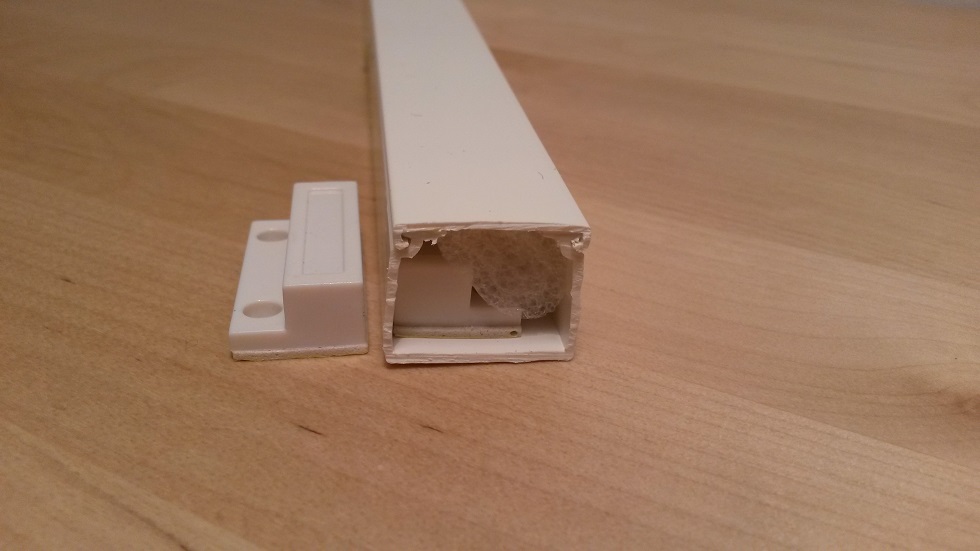
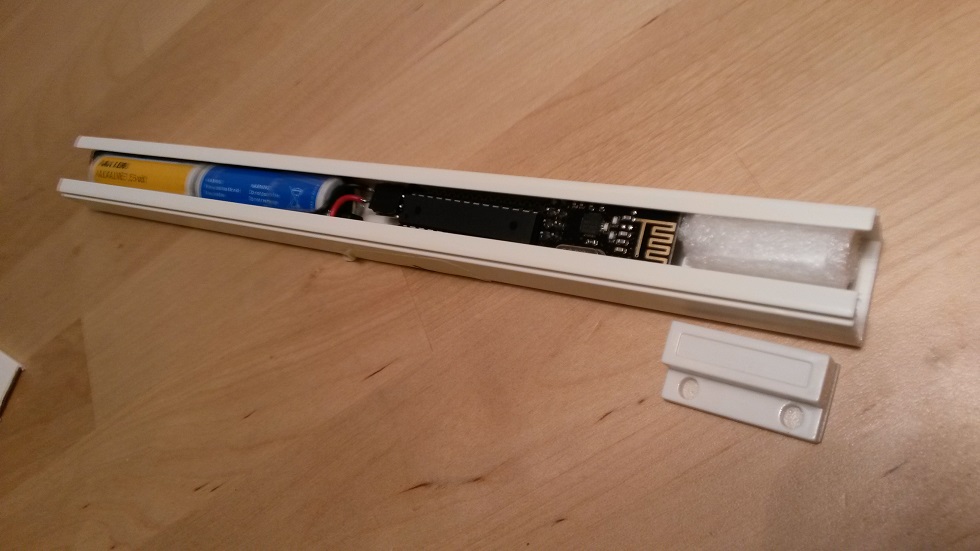
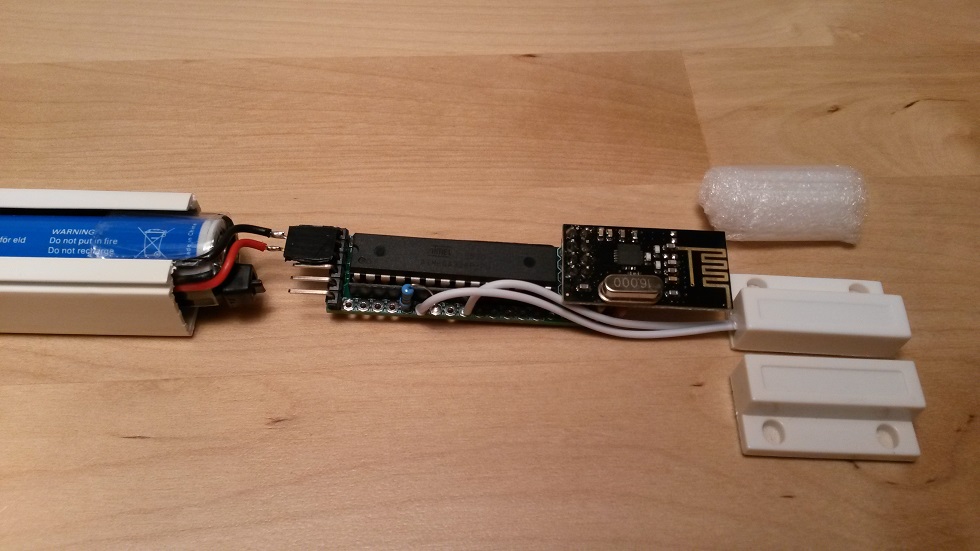
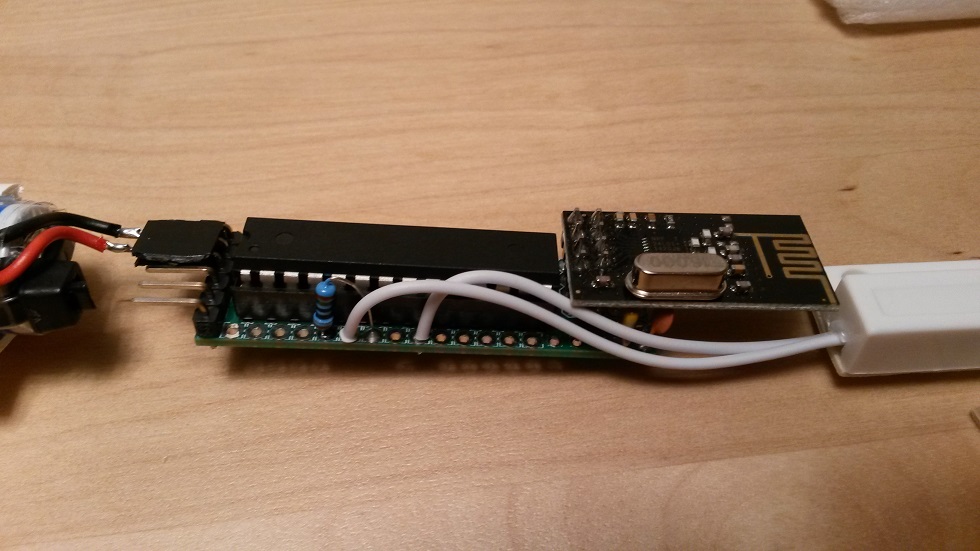

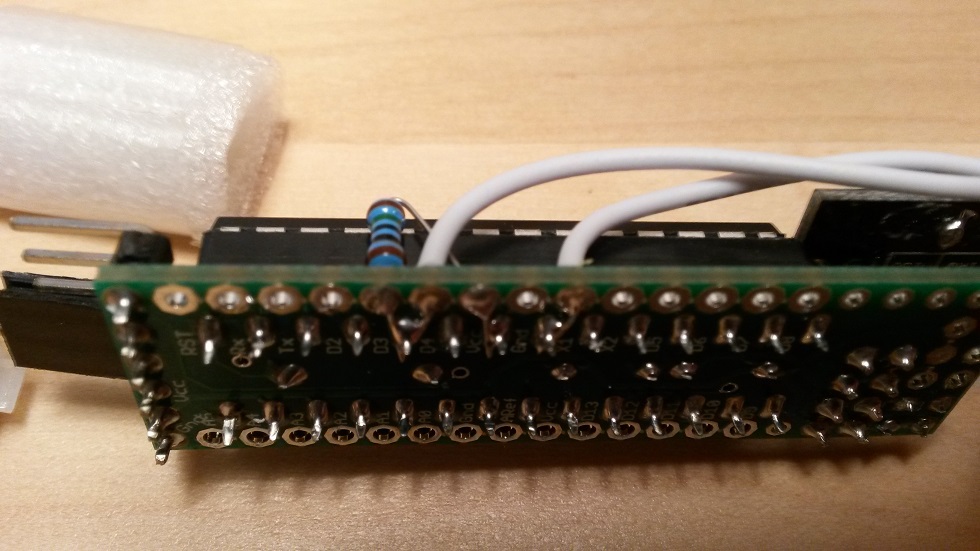
The Sketch
// EgSlimReed2 // By m26872, 2015-12-22 // Interrupt driven binary switch for Slim Node with Reed switch and external pull-up (10Mohm) // Inspired by mysensors example: // https://github.com/mysensors/Arduino/blob/master/libraries/MySensors/examples/BinarySwitchSleepSensor/BinarySwitchSleepSensor.ino #include <MySensor.h> #include <SPI.h> #include <Vcc.h> #define NODE_ID 5 //12 var senaste "reed-node"-id // 110 // Use static Node_ID <<<<<<<<<<<<<<<<<<<<<<<<<<<<<<<<<<<<<<<<<<<<<<< #define SKETCH_NAME "EgSlimReed" #define SKETCH_VERSION "2.0 2015-12-22" #define SW_CHILD_ID 5 #define SW_PIN 3 #define BATTERY_REPORT_DAY 2 // Desired heartbeat interval when inactive. Maximum heartbeat/report interval is equal to this due to the dayCounter. #define BATTERY_REPORT_BY_IRT_CYCLE 10 // Adjust this according to usage frequency. #define ONE_DAY_SLEEP_TIME 86400000 #define VCC_MIN 1.9 #define VCC_MAX 3.3 int dayCounter = 0; int irtCounter = 0; uint8_t value; uint8_t sentValue=2; bool interruptReturn=false; Vcc vcc; MySensor gw; MyMessage msg(SW_CHILD_ID, V_TRIPPED); void setup() { delay(100); // to settle power for radio gw.begin(NULL,NODE_ID); pinMode(SW_PIN, INPUT); digitalWrite(SW_PIN, LOW); // Disable internal pull-ups gw.sendSketchInfo(SKETCH_NAME, SKETCH_VERSION); gw.present(SW_CHILD_ID, S_DOOR); } void loop() { if (!interruptReturn) { // Woke up by timer (or first run) dayCounter++; if (dayCounter >= BATTERY_REPORT_DAY) { dayCounter = 0; sendBatteryReport(); } } else { // Woke up by pin change irtCounter++; gw.sleep(50); // Short delay to allow switch to properly settle value = digitalRead(SW_PIN); if (value != sentValue) { gw.send(msg.set(value==HIGH ? 1 : 0)); sentValue = value; } if (irtCounter>=BATTERY_REPORT_BY_IRT_CYCLE) { irtCounter=0; sendBatteryReport(); } } // Sleep until something happens with the sensor, or one sleep_time has passed since last awake. interruptReturn = gw.sleep(SW_PIN-2, CHANGE, ONE_DAY_SLEEP_TIME); } void sendBatteryReport() { float p = vcc.Read_Perc(VCC_MIN, VCC_MAX, true); int batteryPcnt = static_cast<int>(p); gw.sendBatteryLevel(batteryPcnt); } -
Motion sensor example
As already mentioned; more details to be found here.http://forum.mysensors.org/topic/2715/slim-node-as-a-mini-2aa-battery-pir-motion-sensor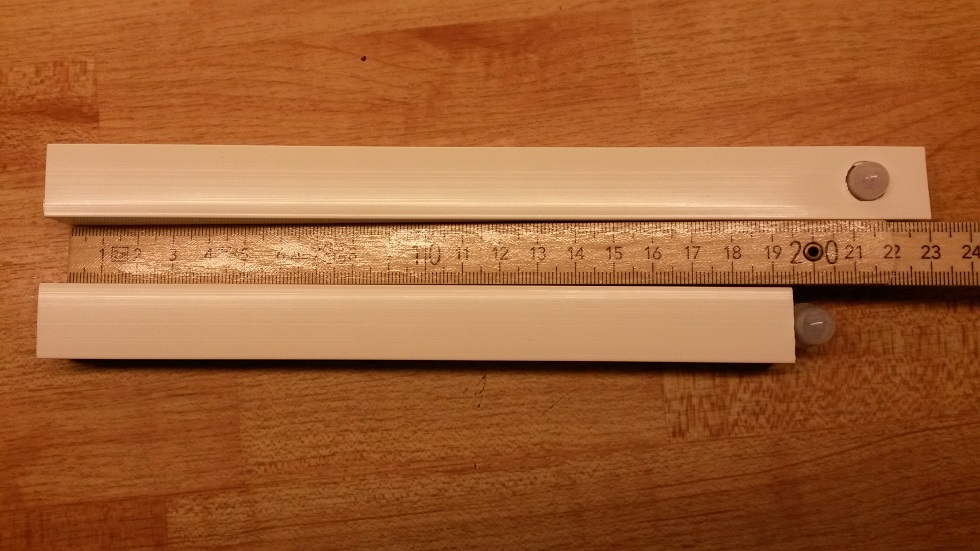
-
do u add these photos and comments to openhardware.io ? they are quite helpful
-
Humidity Sensor example
http://forum.mysensors.org/topic/3049/slim-node-si7021-sensor-example(This post used to contain a not yet finished design by mistake. The link above now shows the correct finished project.)
-
@m26872 I don't use any I2C pull-ups. All my Si7021/ SHT21 (GY-21) boards include the SDA/SCL pull-ups (and LDO voltage regulator/ level conversion).
@AWI
Oops, it makes me worried that I completely forgot that this project was in some test stage. Ldo and everything should probably be bypassed, but I wanted to test it first. Post edited. Thanks for noticing!And sorry for everyone else if this caused any trouble.
(It also makes me a little worried about that I have too many ongoing projects right now. :confounded: )
-
@m26872 I don't use any I2C pull-ups. All my Si7021/ SHT21 (GY-21) boards include the SDA/SCL pull-ups (and LDO voltage regulator/ level conversion).
@AWI said:
@m26872 I don't use any I2C pull-ups. All my Si7021/ SHT21 (GY-21) boards include the SDA/SCL pull-ups (and LDO voltage regulator/ level conversion).
@m26872 said:
@AWI
Oops, it makes me worried that I completely forgot that this project was in some test stage. Ldo and everything should probably be bypassed, but I wanted to test it first. Post edited. Thanks for noticing!And sorry for everyone else if this caused any trouble.
(It also makes me a little worried about that I have too many ongoing projects right now. :confounded: )
Apologies again, so that I understand it, does that mean when adding the mentioned temp sensor nodes I need additional parts?
-
@AWI said:
@m26872 I don't use any I2C pull-ups. All my Si7021/ SHT21 (GY-21) boards include the SDA/SCL pull-ups (and LDO voltage regulator/ level conversion).
@m26872 said:
@AWI
Oops, it makes me worried that I completely forgot that this project was in some test stage. Ldo and everything should probably be bypassed, but I wanted to test it first. Post edited. Thanks for noticing!And sorry for everyone else if this caused any trouble.
(It also makes me a little worried about that I have too many ongoing projects right now. :confounded: )
Apologies again, so that I understand it, does that mean when adding the mentioned temp sensor nodes I need additional parts?
@rsachoc My mistake and my apology. Unfortunatly I can't even finish and share the resluts from that humidity sensor in a while since I'm leaving for a few weeks holiday.
Anyway
@riataman Shows a mod of the GY-21 board in this post. He also link to a board without the LDO and level converter. In any case you wont need the two 4k7 pull-up in my pictures above, only if use the bare chip. -
What about using a hall effect sensor to detect magnet ?
I have a door sensor using the same contact sensor, but I also have a hall effect sensor and I hope to test it soon. It is very small compared to the contact sensor.
-
Hello m26872,
your project is great, and i will order tomorrow a set of PCBs.
I've done a breadboard setup with the SI7021 according to your schematic and your sketch, which works flawlessly.
(ATmega328P / SI7021 / NRF24L01 / 2xAA Battery / your 1Mhz bootloader / your Fuse Settings)Unfortunately I do not get the current consumption below 2mA.
What to do to get the power consumption below 10uA and to increase the battery life on a couple of years ?
Any help is appreciated... -
Hello m26872,
your project is great, and i will order tomorrow a set of PCBs.
I've done a breadboard setup with the SI7021 according to your schematic and your sketch, which works flawlessly.
(ATmega328P / SI7021 / NRF24L01 / 2xAA Battery / your 1Mhz bootloader / your Fuse Settings)Unfortunately I do not get the current consumption below 2mA.
What to do to get the power consumption below 10uA and to increase the battery life on a couple of years ?
Any help is appreciated...@sensorchecker A power consumption of 2mA is way out of range. Is your sensor entering sleep? Or an ftdi adapter still connected?
-
No FTDI Adapter, no LED and nothing else is connected.
I build the node like the schematic in the first post.
When i start the sensor node, power consumption is about 16mA.
After a few seconds (4-5sec) the current goes down to 2mACan you please tell me, how to find out, that the node is in sleep mode
I have really no idea how to fix that.. but i have to, because i ordered the PCBs today!Thanks for your help
-
No FTDI Adapter, no LED and nothing else is connected.
I build the node like the schematic in the first post.
When i start the sensor node, power consumption is about 16mA.
After a few seconds (4-5sec) the current goes down to 2mACan you please tell me, how to find out, that the node is in sleep mode
I have really no idea how to fix that.. but i have to, because i ordered the PCBs today!Thanks for your help
@sensorchecker I think you should start with a simple example like the "reed switch sensor" and by looking at the other sketches you should be able to add some debug prints yourself. You only need a high ohm resitor 1M-10M and two pieces of wire to simulate a button or switch.
-
can i run it on 5V without any problem.
For the RF433 interface i need 5V so i would like to make one that is powerd by an usb charger.
-
@m26872
I have already tested the "reed switch sensor" and it works fine for me- but with a power consumption of 2mA ...:-(
Is it possible that i have a problem with the bootloader or the fuses ?
How can i check that ?
Usually i use USBASP and avrdude for programming the processors on breadboards.
Is it also possible to do the whole programming with the arduino IDE ? -
@m26872
I have already tested the "reed switch sensor" and it works fine for me- but with a power consumption of 2mA ...:-(
Is it possible that i have a problem with the bootloader or the fuses ?
How can i check that ?
Usually i use USBASP and avrdude for programming the processors on breadboards.
Is it also possible to do the whole programming with the arduino IDE ?@sensorchecker did you try changing your nrf ?
-
@sensorchecker and @m26872 changing the NRF module did work for me as well.
I was struggling a lot getting the power consumption down using all the trick and tips as described on the mysensors forum but nothing worked for by battery powered nodes (i have a couple these ).
I was not able to bring the power consumption down below 2.4 mA (with the NFR mounted) finally i just, for an differnt experiment, i took a "fresh"NRF and just for the fun i measured the current and it was down to 0.05 mA for no reason. They came from the same batch.
My theory now is that i broke the first radio module during programming of the node, although the FTDI serial module is in 3.3v mode it still measures around 4.5 volt. So the voltage might has damaged my NRF radio a bit (it still communicates).
-
@ahmedadelhosni and @BartE and @m26872 you made my day...!
Changing the NRF module was the solution, now my power consumption is about 8uA.
Now waiting for the PCBs and parts to build 10- 15 nodesThank you so much for your help
